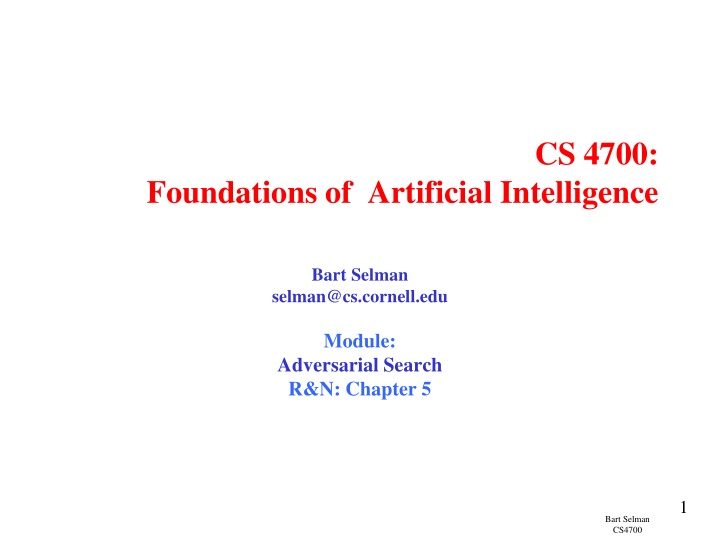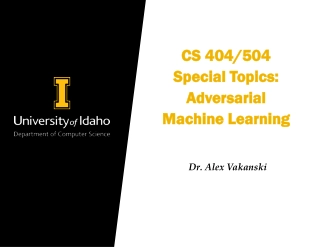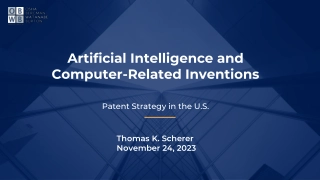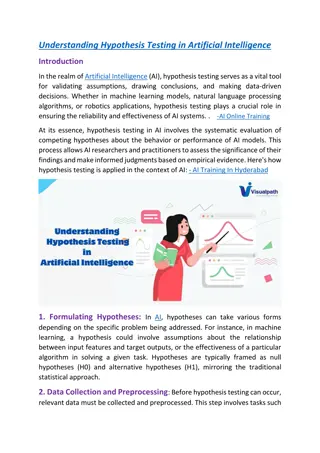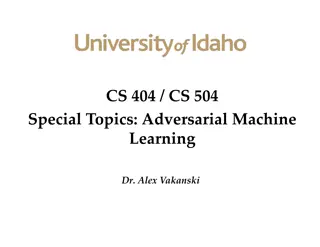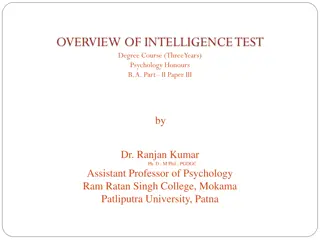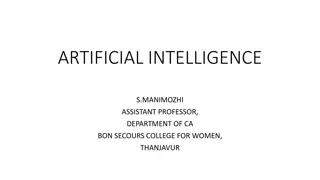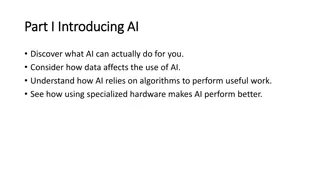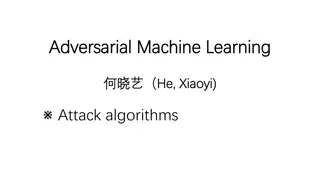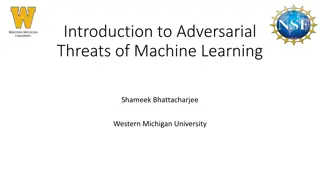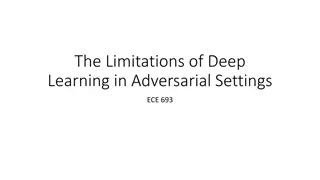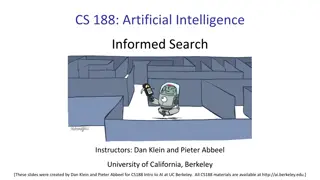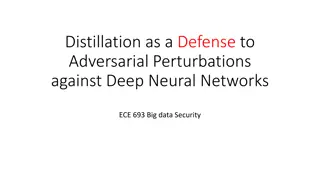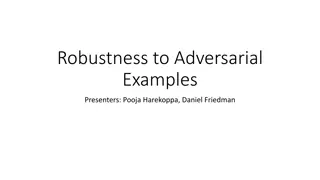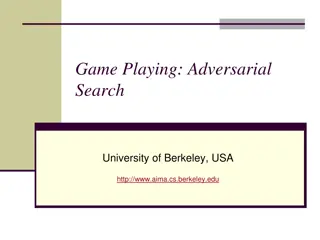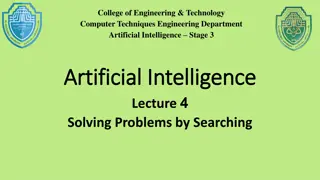Adversarial Search in Artificial Intelligence
Adversarial search in AI involves making optimal decisions in games through concepts like minimax and pruning. It explores the strategic challenges of game-playing, from deterministic turn-taking to the complexities of multi-agent environments. The history of computer chess and the emergence of human-computer hybrids illustrate the evolution of AI in gaming. Game-playing poses a significant challenge for AI, requiring intelligence, planning, and adaptability due to the unpredictable nature of opponents.
Download Presentation

Please find below an Image/Link to download the presentation.
The content on the website is provided AS IS for your information and personal use only. It may not be sold, licensed, or shared on other websites without obtaining consent from the author.If you encounter any issues during the download, it is possible that the publisher has removed the file from their server.
You are allowed to download the files provided on this website for personal or commercial use, subject to the condition that they are used lawfully. All files are the property of their respective owners.
The content on the website is provided AS IS for your information and personal use only. It may not be sold, licensed, or shared on other websites without obtaining consent from the author.
E N D
Presentation Transcript
CS 4700: Foundations of Artificial Intelligence Bart Selman selman@cs.cornell.edu Module: Adversarial Search R&N: Chapter 5 1 Bart Selman CS4700
Outline Adversarial Search Optimal decisions Minimax - pruning Case study: Deep Blue UCT and Go 2 Bart Selman CS4700
Adversarial Reasoning: Games Mathematical Game Theory Branch of economics that views any multi-agent environment as a game, provided that the impact of each agent on the others is significant , regardless of whether the agents are cooperative or competitive. First step: Deterministic Turn taking 2-player Zero-sum game of perfect information (fully observable) my win is your loss and vice versa; utility of final states opposite for each player. My +10 is your -10. 3 Bart Selman CS4700
Game Playing vs. Search Multi-agent game vs. single-agent search problem "Unpredictable" opponent need a strategy: specifies a move for each possible opponent reply. E.g with huge lookup table. Time limits approximate unlikely to find optimal response, must Rich history of game playing in AI, in particular in the area of chess. Both Turing and Shannon viewed chess as an important challenge for machine intelligence because playing chess appears to require some level of intelligence. 4 Bart Selman CS4700
A Brief History of Computer Chess 1997 1912 1970s 1950s 5 Today Bart Selman CS4700
Human-computer hybrid most exciting new level of play. Computers as smart assistants are becoming accepted. Area referred to as Assisted Cognition. 6 Bart Selman CS4700
Why is Game-Playing a Challenge for AI? Competent game playing is a mark of some aspects of intelligence Requires planning, reasoning and learning Proxy for real-world decision making problems Easy to represent states & define rules Obtaining good performance is hard Adversary can be nature PSPACE-complete (or worse) Computationally equivalent to hardware debugging, formal verification, logistics planning PSPACE believed to be harder than NP. 7 Bart Selman CS4700
Traditional Board Games Finite Two-player Zero-sum Deterministic Perfect Information Sequential 8 Bart Selman CS4700
Tic-tac-toe (or Noughts and crosses, Xs and Os) Key Idea: Look Ahead We start 3 moves per player in: 3x3 Tic-Tac-Toe optimal play X s turn O s turn X loss loss 9 Bart Selman CS4700
Look-ahead based Tic-Tac-Toe X s turn O s turn X Tie Tie Tie Tie 10 Bart Selman CS4700
Look-ahead based Tic-Tac-Toe X s turn O s turn Loss for X Loss for X Tie Tie Tie Tie 11 Bart Selman CS4700
Look-ahead based Tic-Tac-Toe X s turn O s turn Loss for X Loss for X Tie Tie Tie Tie 12 Bart Selman CS4700
Look-ahead based Tic-Tac-Toe X s turn Loss for X Loss for X Tie O s turn Loss for X Loss for X Tie Tie Tie Tie 13 Bart Selman CS4700
Each board in game tree gets unique game tree value (utility; -1/0/+1) under optimal rational play. (Convince yourself. Proof?) E.g. 0 for top board. What if our opponent does not play optimally? X s turn Loss for X Loss for X Tie Approach: Look first at bottom tree. Label bottom-most boards. Then label boards one level up, according result of best possible move. and so on. Moving up layer by layer. Termed the Minimax Algorithm Implemented as a depth-first search 14 Bart Selman CS4700
Aside: Game tree learning Can (in principle) store all board values in large table. 3^19 = 19,683 for tic-tac-toe. Can use table to try to train classifier to predict win , loss , or draw. Issue: For real games, one can only look at tiny, tiny fragment of table. Reinforcement learning builds on this idea. See eg Irvine Machine Learning archive. archive.ics.uci.edu/ml/datasets/Tic-Tac-Toe+Endgame 15 Bart Selman CS4700
Look-ahead based Chess But there s a catch X s turn White s turn O s turn Black s turn X 16 Bart Selman CS4700
How big is this tree? ~35 moves per position ~80 levels deep Approx. 10^120 > Number of atoms in the observable universe (10^80) We can really only search a tiny, miniscule faction of this tree! Around 60 x 10^9 nodes for 5 minute move. Approx. 1 / 10^70 fraction. 17 Bart Selman CS4700
Whats the work-around? Don t search to the very end Go down 10-12 levels (still deeper than most humans) What do humans do? But now what? Compute an estimate of the position s value This heuristic function is typically designed by a domain expert Consider a game tree with leaf utilities (final boards) +1 / 0 / -1 (or +inf / 0 inf). What are the utilities of intermediate boards in the game tree? +1 / 0 / -1 (or +inf / 0 / -inf) The board heuristics is trying to estimate these values from a quick calculation on the board. Eg, considering material won/loss on chess board or regions captures in GO. Heuristic value of e.g. +0.9, suggests true value may be +1. Probability of winning (Really?) 18 Bart Selman CS4700
What is a problem for the board heuristics (or evaluation functions) at the beginning of the game? (Consider a heuristics that looks at lost and captured pieces.) What will the heuristic values be near the top? Close to 0! Not much has happened yet . Other issue: children of any node are mostly quite similar. Gives almost identical heuristic board values. Little or no information about the right move. Solution: Look ahead. I.e., build search tree several levels deep (hopefully 10 or more levels). Boards at bottom of tree more diverse. Use minimax search to determine value of starting board, assuming optimal play for both players. (max player picks board with max value among its children; min player picks board with min value among its childern.) 19 Bart Selman CS4700
Intriguing aside: What is the formal computational complexity of chess? Use Big-O notation. (Discussed before.) IBM knew this when they acquired the Deep Thought team. They could predict what it would take to beat Kasparov. 20 Bart Selman CS4700
Will deeper search give stronger play? Always?And why? Very counterintuitive: there are artificial games where searching deeper leads to worse play! (Nau and Pearl 1980) Not in natural games! Game tree anomaly. Heuristic board eval value is sometimes informally referred to as the chance of winning from that position. That s a bit odd, because in a deterministic game with perfect information and optimal play, there is no chance at all! Each board has a fixed utility: -1, 0, or +1 (a loss, draw, or a win). (result from game theory) Still, chance of winning is an informally useful notion. But, remember, no clear semantics to heuristic values. What if board eval gives true board utility? How much search is needed to make a move? We ll see that using machine learning and self play, we can get close for backgammon. 21 Bart Selman CS4700
Limitations? Two important factors for success: Deep look ahead Good heuristic function Are there games where this is not feasible? 22 Bart Selman CS4700
Limitations? Looking 14 levels ahead in Chess Looking 4 levels ahead in Go Two important factors for success: Deep look ahead Good heuristic function Are there games where this is not feasible? 23 Bart Selman CS4700
Limitations? Looking 14 levels ahead in Chess Looking 4 levels ahead in Go Two important factors for success: Deep look ahead Good heuristic function Are there games where this is not feasible? Moves have extremely delayed effects 24 Bart Selman CS4700
Limitations? Looking 14 levels ahead in Chess Looking 4 levels ahead in Go Two important factors for success: Deep look ahead Good heuristic function Are there games where this is not feasible? Moves have extremely delayed effects Minimax players for GO were very weak until 2007 but then play at master level. Now, AlphaGo world champion. 25 Bart Selman CS4700
Limitations? Looking 14 levels ahead in Chess Looking 4 levels ahead in Go Two important factors for success: Deep look ahead Good heuristic function Are there games where this is not feasible? Moves have extremely delayed effects New sampling based search method: Upper Confidence bounds applied to Trees (UCT) Monte Carlo sampling of lines of play. Remarkably effective. 26 Bart Selman CS4700
Well Why not use a strategy / knowledge, as humans do? Consider for Tic-Tac-Toe: Rule 3 Rule 4 Sounds reasonable right? Oops!! Consider Black uses the strategy Rule 2 27 Bart Selman CS4700
So, although one can capture strategic knowledge of many games in high-level rules (at least to some extent), in practice any interesting game will revolve precisely around the exceptions to those rules! Issue has been studied for decades but research keeps coming back to game tree search (or most recently, game tree sampling). Currently only one exception: reinforcement learning for backgammon. (discussed later) A very strong board evaluation function was learned in self-play. Represented as a neural net. Minimal search remained (backgammon) or sampling search (AlphaGo). 28 Bart Selman CS4700
Formal definition of a game: Initial state Successor function: returns list of (move, state) pairs Terminal test: determines when game over Terminal states: states where game ends Utility function (objective function or payoff function): gives numeric value for terminal states We will consider games with 2 players (Max and Min) Max moves first. 29 Bart Selman CS4700
Game Tree Example: Tic-Tac-Toe Tree from Max s perspective 30 Bart Selman CS4700
Minimax Algorithm Minimax algorithm Perfect play for deterministic, 2-player game Max tries to maximize its score Min tries to minimize Max s score (Min) Goal: Max to move to position with highest minimax value Identify best achievable payoff against best play 31 Bart Selman CS4700
Minimax Algorithm Payoff for Max 32 Bart Selman CS4700
Minimax Algorithm (cont d) 3 9 0 7 2 6 Payoff for Max 33 Bart Selman CS4700
Minimax Algorithm (cont d) 3 0 2 3 9 0 7 2 6 Payoff for Max 34 Bart Selman CS4700
Minimax Algorithm What if payoff(Q) = 100 payoff(R) = 200 Starting DFS, left to right, do we even need to know eval(H)? Do DFS. Real games: use iterative deepening. (gives anytime approach.) (DFS left to right) >= 3 3 <= 2 <= 0 alpha-beta pruning 3 0 2 Prune! Prune! 3 9 0 7 2 6 Payoff for Max 35 Bart Selman CS4700
here Properties of minimax algorithm: Complete? Yes (if tree is finite) Optimal? Yes (against an optimal opponent) Time complexity? O(bm) Space complexity? O(bm) (depth-first exploration, if it generates all successors at once) For chess, b 35, m 80 for "reasonable" games exact solution completely infeasible m maximum depth of the tree; b legal moves 36 Bart Selman CS4700
Minimax Algorithm Limitations Generally not feasible to traverse entire tree Time limitations Key Improvements Use evaluation function instead of utility (discussed earlier) Evaluation function provides estimate of utility at given position Alpha/beta pruning 37 Bart Selman CS4700
- Pruning Can we improve search by reducing the size of the game tree to be examined? Yes! Using alpha-beta pruning Principle If a move is determined worse than another move already examined, then there is no need for further examination of the node. Analysis shows that will be able to search almost twice as deep. Really is what makes game tree search practically feasible. E.g. Deep Blue 14 plies using alpha-beta pruning. Otherwise only 7 or 8 (weak chess player). (plie = half move / one player) 38 Bart Selman CS4700
- Pruning Example 39 Bart Selman CS4700
40 Bart Selman CS4700
41 Bart Selman CS4700
42 Bart Selman CS4700
Note: order children matters! What gives best pruning? Visit most promising (from min/max perspective) first. 43 Bart Selman CS4700
Alpha-Beta Pruning Rules: is the best (highest) found so far along the path for Max is the best (lowest) found so far along the path for Min Search below a MIN node may be alpha-pruned if its <= of some MAX ancestor Search below a MAX node may be beta-pruned if its >= of some MIN ancestor. See also fig. 5.5 R&N. 44 Bart Selman CS4700
More abstractly is the value of the best (i.e., highest-value) choice found so far at any choice point along the path for max If vis worse than , max will avoid it prune that branch Define similarly for min 45 Bart Selman CS4700
Properties of - Prune Pruning does not affect final result Good move ordering improves effectiveness of pruning b(e.g., chess, try captures first, then threats, froward moves, then backward moves ) With "perfect ordering," time complexity = O(bm/2) doubles depth of search that alpha-beta pruning can explore Example of the value of reasoning about which computations are relevant (a form of metareasoning) 46 Bart Selman CS4700
A few quick approx. numbers for Chess: b = 35 200M nodes / second ===> 5 mins = 60 B nodes in search tree (2 M nodes / sec. software only, fast PC ===> 600 M nodes in tree) 35^7 = 64 B 35^5 = 52 M So, basic minimax: around 7 plies deep. (5 plies) With, alpha-beta 35^(14/2) = 64 B. Therefore, 14 plies deep. (10 plies) Aside: 4-ply human novice 8-ply / 10-ply typical PC, human master (not exhaustive!) 14-ply Deep Blue, Kasparov (not exhaustive!; + depth 25 for selective extensions ) / 7 moves by each player. 47 Bart Selman CS4700
Resource limits Can t go to all the way to the bottom: evaluation function = estimated desirability of position cutoff test: e.g., depth limit (Use Iterative Deepening) What is the problem with that? Horizon effect. Unstable positions: Search deeper. Selective extensions. E.g. exchange of several pieces in a row. add quiescence search: quiescent position: position where next move unlikely to cause large change in players positions 48 Bart Selman CS4700
Evaluation Function Performed at search cutoff point Must have same terminal/goal states as utility function Tradeoff between accuracy and time reasonable complexity Accurate Performance of game-playing system dependent on accuracy/goodness of evaluation Evaluation of nonterminal states strongly correlated with actual chances of winning 49 Bart Selman CS4700
For chess, typically linear weighted sum of features Evaluation functions Eval(s) = w1 f1(s) + w2 f2(s) + + wn fn(s) e.g., w1 = 1 with f1(s) = (number of white pawns) (number of black pawns), etc. Key challenge find a good evaluation features: Not just material! (as used by novice) Isolated pawns are bad. How well protected is your king? How much maneuverability to you have? Do you control the center of the board? Strategies change as the game proceeds Combination of inaccurate board eval + search is very effective. (empirical finding!) Features are a form of chess knowledge. Hand-coded in eval function. Knowledge tightly integrated in search. Feature weights: can be automatically tuned ( learned ). Standard issue in machine learning: Features, generally hand-coded; weights tuned automatically. How? 50 Bart Selman CS4700
